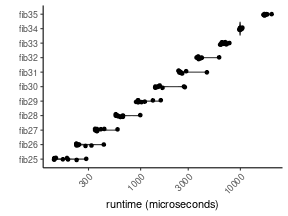Benchmarking Rcpp code with RcppClock
Zach DeBruine — written Nov 6, 2021 — source
Rcpp is all about the need for speed. However, Rcpp code is not magically fast, but is the result of careful coding and profiling. RcppClock makes it easy to profile C++ code from R:
- On the C++ side,
RcppClockwrapsstd::chrono::high_resolution_clock(C++11) to time chunks of code, and exports the results to an R object in the global environment. - On the R side,
RcppClockprovides convenient methods for summarizing results and plotting withggplot2.
There are other Rcpp benchmarking tools, such as the Rcpp timer class (see RcppGallery vignettte here) and rcppgeiger (see repo here). RcppClock moves beyond both of these tools by supporting overlapping time points and direct access to timing results in the R environment.
By benchmarking Rcpp code with RcppClock, we avoid measuring latency associated with converting R types to C++ types (and back again), and we can profile at line-by-line resolution rather than entire functions.
Note: RcppClock is not compatible with OpenMP parallelization, and does not accurately measure processes taking less than ~1 microsecond (somewhat implementation-dependent).
A simple example
Install RcppClock from CRAN:
install.packages("RcppClock")In your .cpp file, link the RcppClock header with //[[Rcpp::depends(RcppClock)]] and, if this is an R package, link to it in your DESCRIPTION file. RcppClock loads Rcpp.h so we don’t need to include it again.
//[[Rcpp::depends(RcppClock)]]
#include <RcppClock.h>
#include <thread>
//[[Rcpp::export]]
void sleepy(){
Rcpp::Clock clock;
clock.tick("both_naps");
clock.tick("short_nap");
std::this_thread::sleep_for(std::chrono::milliseconds(10));
clock.tock("short_nap");
clock.tick("long_nap");
std::this_thread::sleep_for(std::chrono::milliseconds(100));
clock.tock("long_nap");
clock.tock("both_naps");
// send the times to the R global environment variable, named "naptimes"
clock.stop("naptimes");
}.tick(std::string) starts a new timer. Provide a name to record what is being timed.
.tock(std::string) stops a timer. It is important to use the same name as declared in .tick().
.stop(std::string) calculates the duration between all .tick() and .tock() timing results, and creates an object in the R environment with the name provided.
On the R end, we can now summarize the results using the “naptimes” variable that was created in the above Rcpp function:
sleepy()
# global variable "naptimes" is now created in the environment
library(RcppClock)
naptimes
Unit: milliseconds
ticker mean sd min max neval
both_naps 110.19 NA 110.19 110.19 1
long_nap 100.10 NA 100.10 100.10 1
short_nap 10.09 NA 10.09 10.09 1
Multiple replicates
For extremely fast calculations it can be useful to repeat the calculation some number of times in order to improve the accuracy of the measurement.
If a .tick() with the same name is called multiple times, RcppClock automatically groups the results.
The following code reproduces the ?fibonacci function example included in the RcppClock package:
int fib(int n) {
return ((n <= 1) ? n : fib(n - 1) + fib(n - 2));
}
//[[Rcpp::export]]
void fibonacci(std::vector<int> n, int reps) {
Rcpp::Clock clock;
while(reps-- > 0){
for(auto number : n){
clock.tick("fib" + std::to_string(number));
fib(number);
clock.tock("fib" + std::to_string(number));
}
}
clock.stop("clock");
}On the R end, we will get an object named “clock”:
fibonacci(n = 25:35, reps = 10)
# global variable "clock" is created in the R global environment
clockUnit: milliseconds ticker mean sd min max neval fib25 0.1734 0.04975 0.1354 0.2845 10 fib26 0.2651 0.06472 0.2263 0.4273 10 fib27 0.3932 0.07265 0.3493 0.5869 10 fib28 0.6463 0.12682 0.5626 0.9919 10 fib29 1.0641 0.22482 0.8996 1.5922 10 fib30 1.7432 0.53559 1.3993 2.7752 10 fib31 2.7441 0.67205 2.4041 4.6192 10 fib32 4.0757 0.73495 3.6354 6.1233 10 fib33 6.8620 0.49135 6.2664 7.7575 10 fib34 10.0244 0.22531 9.7690 10.4643 10 fib35 17.9276 1.05583 17.1352 20.5875 10
The result of summary() is an S3 object of class RcppClock (essentially a data.frame) and has a plot method using ggplot2:
plot(clock)
Unfortunately, some times were nearly impossible to measure. We can fix this by replicating the calculation many times within each timing bracket:
//[[Rcpp::export]]
void fibonacci_rep(std::vector<int> n, int outer_reps, int inner_reps) {
Rcpp::Clock clock;
while(outer_reps-- > 0){
for(auto number : n){
clock.tick("fib" + std::to_string(number));
for(int rep = 0; rep < inner_reps; ++rep)
fib(number);
clock.tock("fib" + std::to_string(number));
}
}
clock.stop("clock");
}Now on the R end we can account for this:
fibonacci_rep(n = 10:20, outer_reps = 10, inner_reps = 10000)
clock$timer <- clock$timer / 10000
clockUnit: nanoseconds ticker mean sd min max neval fib10 77.66 4.469 71.67 87.31 10 fib11 116.92 8.336 109.19 133.93 10 fib12 206.95 7.735 194.62 218.52 10 fib13 306.46 18.058 290.51 349.29 10 fib14 637.75 69.371 582.90 815.85 10 fib15 909.88 45.979 864.89 1020.59 10 fib16 1782.64 45.661 1735.67 1866.92 10 fib17 2642.99 84.156 2562.64 2832.20 10 fib18 5170.67 126.798 5063.44 5456.16 10 fib19 7485.84 107.298 7319.87 7685.55 10 fib20 14326.20 214.079 14063.28 14684.91 10
And plot the results:
plot(clock)
In conclusion, RcppClock is a non-intrusive method for benchmarking Rcpp code in R.
tags: benchmark
TweetRelated Articles
- Extending R with C++ and Fortran — Dirk Eddelbuettel and JBrandon Duck-Mayr
- Simulation Smoother using RcppArmadillo — Tomasz Woźniak
- Constructing a Sparse Matrix Class in Rcpp — Zach DeBruine and Dirk Eddelbuettel
